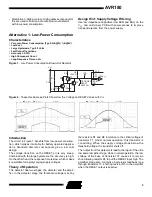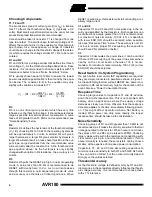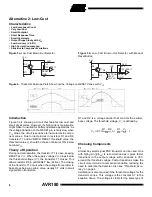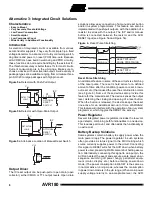
1
AVR180: External Brown-Out Protection
Features
•
Low-Voltage Detector
•
Prevent Register and EEPROM
Corruption
•
Two Discrete Solutions
•
Integrated IC Solution
•
Extreme Low-Cost Solution
•
Extreme Low-Power Solution
•
Formulas for Component Value
Calculations
•
Complete with Example Schematics
Introduction
This application note shows in detail how
to prevent system malfunction during
periods of insufficient power supply volt-
age. It describes techniques to prevent
the CPU from executing code during
periods of low power by use of external
low voltage detectors. These events are
often referred to as “Brown-Outs”, where
power supply voltage drops to an insuffi-
cient level, or “Black-Outs” where power
supply voltage is completely removed for
a period of time.
Two discrete solutions are discussed in
detail, allowing the user to calibrate the
system requirements. A complete guide
to integrated circuit (IC) solutions is also
included. By the use of these tech-
niques, the following can be prevented in
the situations described above:
• CPU Register corruption
• I/O Register corruption
• I/O-pin random toggling
• SRAM corruption
• EEPROM corruption
• External Non-Volatile Memory
corruption
Note that AVR
®
internal Flash Program
Memory contents are never affected by
insufficient power supply voltage.
Theory of Operation
For the CPU to successfully decode and
execute instructions, the supplied volt-
age must always stay above the mini-
mum voltage level set by the chosen
operating frequency. When supplied
voltage drops below this level, the CPU
may start to execute some instructions
incorrectly. The result is unexpected
activity on the internal data and control
lines. This activity may cause CPU Reg-
isters, I/O Registers and data memories
to get corrupted.
To a void these p ro ble ms, the CPU
should be prevented from executing
code during periods of insufficient supply
voltage. This is best ensured by the use
of an external Power Supply Low Volt-
age Detector. Below a fixed threshold
voltage V
T
, the detector circuit forces the
RESET pin low (active). Forcing RESET
low immediately stops the CPU from
executing code. While the supplied volt-
age is below the required threshold volt-
age V
T
, the MCU is halted, making sure
the system stays in a known state. When
the supplied voltage rises above this pre-
defined voltage, the RESET pin is again
released, and the MCU starts to execute
code b eginn in g at th e re se t ve ctor
(0x0000).
Threshold Voltage
It is recommended to set the threshold
voltage 5-15% below typical V
CC
, to
allow for small fluctuations in supplied
voltage. The threshold voltage should
always be selected to ensure that the
detector will keep the device properly
reset when supply voltage drops below
the critical voltage required by the CPU.
Care should be taken to ensure suffi-
ciently high detector threshold voltage
even in worst case situations.
8-Bit
Microcontroller
Application
Note
Rev. 1051A–10/98
Summary of Contents for AVR180
Page 10: ...AVR180 10...
Page 11: ...AVR180 11...






























